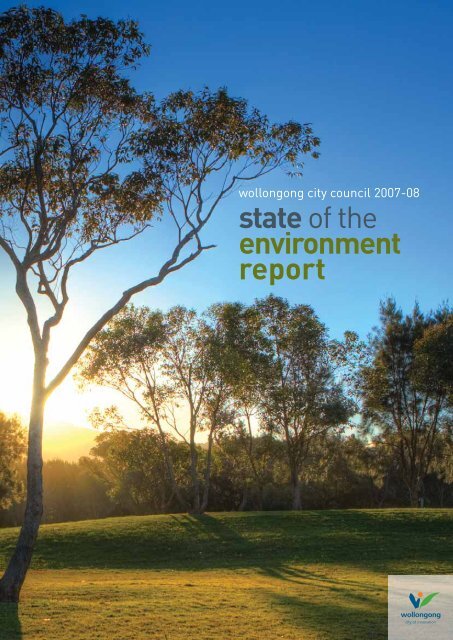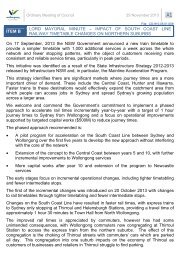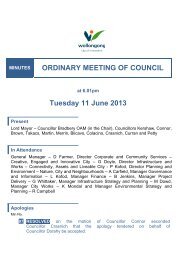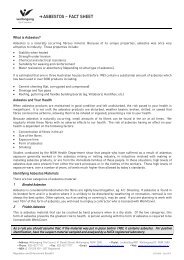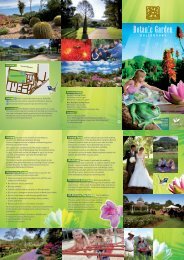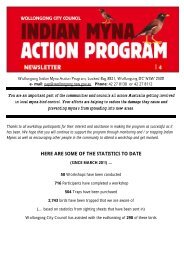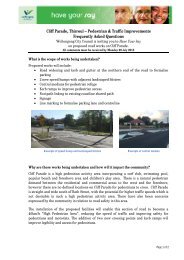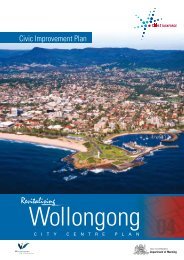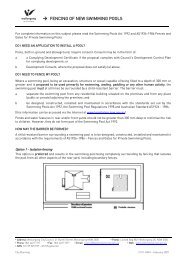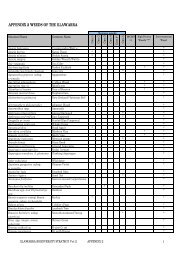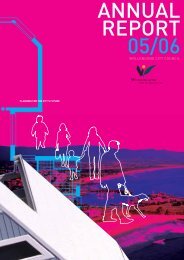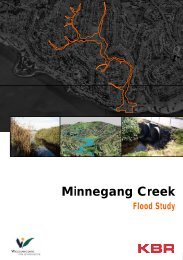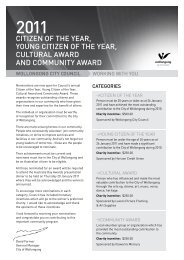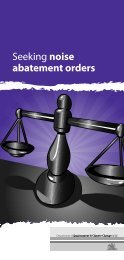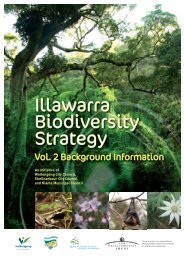State of Environment Report 2007-08 - Wollongong City Council
State of Environment Report 2007-08 - Wollongong City Council
State of Environment Report 2007-08 - Wollongong City Council
Create successful ePaper yourself
Turn your PDF publications into a flip-book with our unique Google optimized e-Paper software.
Map <strong>of</strong> <strong>Wollongong</strong> <strong>City</strong> <strong>Council</strong>Local Government AreaHelensburghStanwell ParkWombarraAustinmerThirroulWoononaMount OusleyBellambiMount KeiraMount KemblaFigtreeUnanderraBerkeleyFairy MeadowNorth <strong>Wollongong</strong><strong>Wollongong</strong>Port KemblaDaptoYallahLakeIllawarraWindangWarillaWarrawong
Land (murum) | <strong>State</strong> <strong>of</strong> the <strong>Environment</strong> <strong>Report</strong> <strong>2007</strong>-20<strong>08</strong>Land (murum)Land (murum)Current state and pressuresLand features in terms <strong>of</strong> the regionaltopography, geology and soils, havedetermined the nature <strong>of</strong> urbandevelopment in the <strong>Wollongong</strong> LocalGovernment Area (LGA). The LGA covers71,400ha in a narrow coastal stripstretching from Helensburgh in the north,to Windang, 30km to the south. The LGA hastwo major Local <strong>Environment</strong>al Plans(LEPs); the <strong>Wollongong</strong> LEP 1990 and the<strong>Wollongong</strong> <strong>City</strong> Centre LEP <strong>2007</strong>. Land usezones within the <strong>Wollongong</strong> LGA and theirpercentage areas are shown in Tables 1and 2.Urban development is concentrated within arelatively narrow coastal strip between theTasman Sea and the Illawarra Escarpment.The proportion <strong>of</strong> urban land increasestoward the southern half <strong>of</strong> the LGA, withlimited development and developmentpotential in the northern suburbs. Thedemand for new dwellings in <strong>Wollongong</strong>has increased over time due to a declininghousehold occupancy rate and immigration.During <strong>2007</strong>-<strong>08</strong>, a total <strong>of</strong> 352 residentiallots were created in the <strong>Wollongong</strong> LGA.Major responsesDraft <strong>Wollongong</strong> Local <strong>Environment</strong>al Plan2009Since the adoption <strong>of</strong> the <strong>Wollongong</strong> LEP in1990, there has been a significant change incommunity attitudes and expectations,including environmental awareness andaccountabilities about development in the<strong>Wollongong</strong> LGA. In November 2004,<strong>Council</strong> resolved to commence preparing adraft LEP to replace the LEP 1990. The draft<strong>Wollongong</strong> LEP 2009 was prepared by:● Translating the provisions <strong>of</strong> the<strong>Wollongong</strong> LEP 1990 and <strong>Wollongong</strong><strong>City</strong> Centre LEP <strong>2007</strong> into the requiredformat <strong>of</strong> the standard LEP instrument.● Incorporating planning recommendations<strong>of</strong> a number <strong>of</strong> studies including the<strong>Wollongong</strong> Housing Study (2005),<strong>Wollongong</strong> Employment Land Study(2005), <strong>Wollongong</strong> Retail Centre Study(2004), Planning People Places - OpenSpace, Recreation and CommunityFacilities Strategic Framework, IllawarraEscarpment Strategic Management Plan(2005) and Illawarra Escarpment LandUse Provision (<strong>2007</strong>), Port <strong>of</strong> Port KemblaLand Use Strategy (<strong>2007</strong>), HelensburghLand Capacity Analysis (2006), DarkesForest Review <strong>of</strong> Deferred Lands (<strong>2007</strong>),Kanahooka Road 6(b) Lands Study(<strong>2007</strong>), Illawarra Coal Mines HeritageStudy (2006) and various floodplain strategies and estuarymanagement plans.● Incorporating rezoning proposals reviewed by theAdministrators and suggestions made by Statutory Authorities.● The draft LEP was endorsed by <strong>Council</strong> in June 20<strong>08</strong> andsubmitted to the Department <strong>of</strong> Planning for review andcertification prior to exhibition.<strong>Wollongong</strong> Development Contributions Plan (Section 94A)The <strong>Wollongong</strong> Section 94A Contributions Plan came into effect inJune 2006. In adopting the plan, all existing Section 94 Plans, withthe exception <strong>of</strong> Horsley, have been repealed. The Section 94A Planrequires the payment <strong>of</strong> contributions based on the value <strong>of</strong> adevelopment. The contributions allow <strong>Council</strong> to construct orprovide public infrastructure, amenities and services required.During <strong>2007</strong>-<strong>08</strong>, <strong>Council</strong> reviewed, exhibited and adopted anupdated Plan incorporating minor amendments and an updatedworks schedule.Blue MileRedevelopment <strong>of</strong> the city foreshore was identified in theRevitalising <strong>Wollongong</strong> <strong>City</strong> Centre Plan (2006) as one <strong>of</strong> eightstrategic civic improvement projects for the revitalisation andgrowth <strong>of</strong> the city.The Blue Mile is a multi-million dollar staged plan to revitaliseinfrastructure, recreation and tourism experiences in the cityforeshore area stretching from <strong>City</strong> Beach in the south to StuartPark in the north. The master plan addresses public facilities,beaches and open space, parks and playgrounds, recreationfacilities, footpaths, cafes and restaurants, tourism and othercommercial opportunities, pedestrian and traffic movement andcar parking issues.The Blue Mile Master Plan process led to the development <strong>of</strong> adraft <strong>City</strong> Foreshore Plan <strong>of</strong> Management. The Blue Mile MasterPlan was adopted by <strong>Council</strong> in November <strong>2007</strong>. The <strong>Wollongong</strong><strong>City</strong> Foreshore Plan <strong>of</strong> Management was adopted by <strong>Council</strong> inJanuary 20<strong>08</strong>.Works in Belmore Basin/Brighton Lawn Reserve were considereda priority due to the impending failure <strong>of</strong> the coastal protectionworks, public risk and the degraded nature <strong>of</strong> the Brighton LawnENVIRONMENTAL 2004-05 2005-06 2006-07 <strong>2007</strong>-<strong>08</strong>INDICATORSNumber <strong>of</strong> DAs received 2,643 2,139 2,040 2,236Number <strong>of</strong> complyingdevelopments received(inc Private Certifiers)999 528 438 361Number <strong>of</strong> DAs determined 2,680 2,312 2,191 2,093Number <strong>of</strong> complyingdevelopments determined(inc Private Certifiers)984 525 436 355Number <strong>of</strong> constructioncertificates issued (incPrivate Certifiers)Number <strong>of</strong> complyingdevelopments(inc Private Certifiers)1,802 1,579 1,057 1,466549 524 431 354Number <strong>of</strong> lots produced 475 216 346 352DA - Development Applications<strong>Wollongong</strong> <strong>City</strong> <strong>Council</strong> 05
Land (murum) | <strong>State</strong> <strong>of</strong> the <strong>Environment</strong> <strong>Report</strong> <strong>2007</strong>-20<strong>08</strong>Land (murum)Table 1 Land use zones within the <strong>Wollongong</strong> Local <strong>Environment</strong>al Plan 1990ZONES AREA IN HECTARES % <strong>of</strong>CITY AREASubtotalTotal1. Non Urban 4,106 5.7502. Residential(a1) Special Low Density(a) Low Density(b) Medium Density(c) High Density3. Business(a) General Business(b) Neighbourhood Business(c) Commercial Business(d) Research anddevelopment4. Industrial(a) Light Industrial(b) Heavy Industrial(c) Extractive Industry5. Special Uses(a) Named Special Use(b) Railway(c) Main Road6. Open Space(a) Public Recreation(b) Private Recreation(c) Tourism7. <strong>Environment</strong>al Protection(a) Special(b) Conservation(c) Residential(c1) Rural Residential(d) Hacking River8. Conservation(a) National Parks(b) <strong>State</strong> Recreation Area9. Reservations for Use(a ) Named Special Use(b) Main Road(c) Local Road(d) Open Space2194,4661,3301-98185829-5331,3331221,0485491,1771,6895388237,4464,423464831,5555,4957311391076,016----203----1,988---2,774---2,309---43,971-----5,568--157----8.426----0.286----2.784---3.885---3.234---61.584-----7.798--0.220----Deferred 623 0.873Unzoned 3,289 4.606Total Area for <strong>Wollongong</strong>Local <strong>Environment</strong>al Plan 199071,004 ha 99.445%reserve. Work commenced on BrightonLawn Reserve during late June 20<strong>08</strong>. Theworks include replacement <strong>of</strong> the failedcoastal protection works and upgrade <strong>of</strong> theBrighton Lawn Reserve with promenades,regraded connecting pathways, cycleways,improved lighting, park furniture andlandscaping.Crown Street MallSignificant effort was made to reach a finaldecision on the future <strong>of</strong> the Crown StreetMall, the Keira Street Transit Mall and otherpublic transport and pedestrianimprovements across the city centre.Investigations, designs and coordinationworks with other agencies, (including theRoads and Traffic Authority, Ministry <strong>of</strong>Transport and Department <strong>of</strong> Planning)completed during <strong>2007</strong>-<strong>08</strong> will enableresolution and the staged implementation<strong>of</strong> the strategy to commence in late 20<strong>08</strong>-09.West Dapto Land Release AreaIn September 2003, <strong>Council</strong> resolved torecommence the investigations into theWest Dapto Release Area (WDRA) throughthe preparation <strong>of</strong> an LEP. The study areahas an area <strong>of</strong> 4,700ha.A draft West Dapto Master Plan, draft LEP,draft DCP and background studies wereexhibited from 26 September <strong>2007</strong> to 30May 20<strong>08</strong>. One hundred and fortysubmissions were received from thecommunity, landholders, businesses andgovernment authorities. <strong>Council</strong> engagedthe NSW Growth Centres Commission toreview key aspects <strong>of</strong> the West Daptoproposal and the issues raised insubmissions, which will occur in 20<strong>08</strong>-09.The West Dapto Transport Link (WDTL) willprovide access to the future developmentareas within the WDRA and an alternativeaccess for Horsley to reduce the short termisolation <strong>of</strong> the suburb during flood eventsas well as alleviating traffic congestion onBong Bong Road. Negotiations have beenunderway with affected land owners for theacquisition <strong>of</strong> the required land toaccommodate the WDTL. <strong>Council</strong> hascommenced preparation <strong>of</strong> designs for thewestern section <strong>of</strong> Fairwater Drivecontained within the existing road corridorand the Reed Creek Bridge.Development Control PlansA consolidated Development Control Plan isbeing prepared and will be known as the<strong>Wollongong</strong> Development Control Plan 2009(WDCP 2009). <strong>Council</strong> is currently reviewingand amalgamating a number <strong>of</strong> existingDCPs, as well as creating new policies for06 <strong>Wollongong</strong> <strong>City</strong> <strong>Council</strong>
Land (murum) | <strong>State</strong> <strong>of</strong> the <strong>Environment</strong> <strong>Report</strong> <strong>2007</strong>-20<strong>08</strong>Land (murum)inclusion into the WDCP 2009, withcompletion anticipated for the end <strong>of</strong> thenext financial year.Illawarra EscarpmentOne <strong>of</strong> the recommendations <strong>of</strong> theIllawarra Escarpment Commission <strong>of</strong>Inquiry was the preparation <strong>of</strong> anIllawarra Escarpment StrategicManagement Plan (IESMP). FollowingMinisterial endorsement in 2006, <strong>Council</strong>engaged consultants to prepare a review<strong>of</strong> land use in the escarpment.The Illawarra Escarpment Land UseReview Strategy (IELURS) examined landuse on the escarpment in accordance withsustainability objectives defined in theIESMP. The IELURS was informed by anIndigenous and non-Indigenous HeritageStudy and a Visual Quality Analysis. TheIELURS, along with its recommendedamendments to the draft <strong>Wollongong</strong> LEP<strong>2007</strong>, was presented to <strong>Council</strong> forendorsement in August <strong>2007</strong>. The draft<strong>Wollongong</strong> Development Control Plan2009 was also amended based on therecommendations arising from theIELURS.<strong>Council</strong> is working with state governmentagencies on the implementation <strong>of</strong> theIESMP through a working group consisting<strong>of</strong> members from the Department <strong>of</strong>Climate Change, Southern RiversCatchment Management Authority and theDepartment <strong>of</strong> Lands. The objectives <strong>of</strong>the group include the attraction andadministration <strong>of</strong> funds for implementingon-ground works on the IllawarraEscarpment. <strong>Council</strong> is currentlydeveloping a Vertebrate Pest ManagementPolicy to help guide the management <strong>of</strong>vertebrate pests on the IllawarraEscarpment and coastal plain.Community LandUnder the Local Government Act 1993,<strong>Council</strong> is required to categorise allcommunity land into five categories: park,sportsground, general community use,cultural significance and natural areas.There are 538 sites categorised as naturalareas, which are further divided into anadditional five sub-categories: bushland,wetland, escarpment, foreshore andwatercourse. <strong>Council</strong> has approximately784 sites <strong>of</strong> community land, coveringapproximately 2,350ha. These sites <strong>of</strong>community land include <strong>Council</strong> ownedand managed land. <strong>Council</strong> also manages174 areas <strong>of</strong> Crown Reserves.In accordance with the requirements <strong>of</strong>the Local Government Act 1993, theGeneric Plan <strong>of</strong> Management for theCommunity Land <strong>of</strong> <strong>Wollongong</strong> <strong>City</strong> <strong>Council</strong> was adopted in March<strong>2007</strong>. This includes land categorised as park, sportsground,general community use and natural areas, unless they are coveredunder a site specific plan <strong>of</strong> management. This generic plan coversover 95% <strong>of</strong> <strong>Council</strong>’s community land.Site specific plans <strong>of</strong> management are required for approximately5% <strong>of</strong> community land across the <strong>Wollongong</strong> LGA. To date, <strong>Council</strong>has adopted the following site specific plans <strong>of</strong> management:<strong>Wollongong</strong> <strong>City</strong> Foreshore - covering Stuart Park, North Beach,<strong>City</strong> Beach, Osborne Park, Belmore Basin and Lang Park; BeatonPark; Bald Hill; Andrew Lysaght Park; <strong>Wollongong</strong> Botanic Garden- including Gleniffer Brae; Judbooley Parade, Windang; andColedale Beach Reserve. Site specific plans <strong>of</strong> management arebeing prepared for Stanwell Park and Sublime Point.Floodplain Management Plans<strong>Council</strong> is preparing floodplain management plans for all majorcatchments in the <strong>Wollongong</strong> LGA. Each plan will assess floodimpacts on the floodplain and creek environments, as well asidentify structural and non-structural flood mitigation measures tominimise these impacts. <strong>Council</strong> has completed a Plan forTowradgi, Minnegang, Allans and Hewitts creeks (incorporatingSlacky, Tramway, Woodlands and Thomas Gibson creeks). Workcarried out to implement these plans has included: one voluntarypurchase <strong>of</strong> a property in the Allans Creek catchment; twovoluntary purchases <strong>of</strong> properties in the Fairy Creek catchment;investigation <strong>of</strong> upgrading the culverts at Tramway and Woodlandscreeks, upgrading the culvert under the northern distributor atCorrimal; and upgrading the spillway at the detention basin atBarina Park, Minnegang Creek. Preparation <strong>of</strong> the Cabbage Tree/Fairy Creek, Mullet Creek and Lake Illawarra FloodplainManagement plans are also underway.Table 2 Land use zones within the <strong>Wollongong</strong> <strong>City</strong> Centre Local <strong>Environment</strong>al Plan <strong>2007</strong>ZONESAREA INHECTARES% <strong>of</strong> CITYAREATotalR1 General residential 127 0.178B3 Commercial core 62 0.<strong>08</strong>7B4 Mixed use 41 0.057B6 Enterprise corridor 29 0.041IN4 Working waterfront 3 0.004SP1 Special activities - hospitals and19 0.027medical research and developmentSP2 Infrastructure 20 0.028SP3 Tourist 7 0.010RE1 Public recreation 73 0.102RE2 Private recreation 15 0.021Total Area for <strong>Wollongong</strong> <strong>City</strong> CentreLocal <strong>Environment</strong>al Plan <strong>2007</strong>396 ha 0.555%Grand Total for <strong>Wollongong</strong> LocalGovernment Area71,400 ha 100%<strong>Wollongong</strong> <strong>City</strong> <strong>Council</strong> 07
Water (naitnun) | <strong>State</strong> <strong>of</strong> the <strong>Environment</strong> <strong>Report</strong> <strong>2007</strong>-20<strong>08</strong>Water (naitnun)Water (naitnun)Current state and pressuresWater quality in the streams, coastal lagoons and wetlands in the<strong>Wollongong</strong> LGA requires improvement because it generallydoes not meet the water quality guidelines for the protection <strong>of</strong>aquatic ecosystems and primary and secondary recreation. Themain pressures on water quality include sewerage overflows,urban run<strong>of</strong>f, on-site sewage management systems, rural run<strong>of</strong>f,industrial point source discharges, and illegal dumping and litter.During <strong>2007</strong>-<strong>08</strong>, <strong>Council</strong> received a total <strong>of</strong> 207 water pollutioncomplaints from the community, with the majority relating to onsitesewage management systems and run<strong>of</strong>f from sediment andwastewater from residential premises.In accordance with the sewage treatment system licenses, SydneyWater has to advise the Department <strong>of</strong> <strong>Environment</strong> and ClimateChange (DECC) <strong>of</strong> any dry weather sewage overflows. Sydney Waterreported four dry weather overflows during <strong>2007</strong>-<strong>08</strong>.Major responsesEstuary Management Plans<strong>Council</strong> endorsed the Estuary Management Plan for Fairy, Towradgiand Hewitts/Tramway creeks in December 2005. During <strong>2007</strong>-<strong>08</strong>,the following actions were taken to implement the plan:● A boat ramp and viewing platform were constructed at TowradgiCreek, making a valuable addition to the recreational facilitiesavailable to the community in the Towradgi and East Corrimalarea. For years model boat enthusiasts have used the barebank to launch their boats. The Corrimal Surf Life Saving Clubalso used the area for launching their boat and surf life savingtraining. These activities were causing gradual erosion <strong>of</strong> thecreek bank, threatening water quality in the lagoon. Construction<strong>of</strong> the facility allows the use <strong>of</strong> the creek for these activities,whilst protecting it and the surrounding environment fromfurther degradation. The boat ramp is intended for launching <strong>of</strong>non-motorised craft only.● <strong>Council</strong> is conducting a foreshore pollutant audit <strong>of</strong> Towradgiand Fairy creeks. Poor water quality isa critical issue for these creeks whoseestuaries are located in highly urbanisedareas. Stormwater can enter the creeksthrough several sources and currentlythere is no information on the quality <strong>of</strong>these inputs. The purpose <strong>of</strong> this projectis to obtain information on the quality <strong>of</strong>stormwater flows to Fairy and Towradgicreeks and use this information t<strong>of</strong>ormulate potential remediation optionsto improve water quality.● Assessment <strong>of</strong> water quality requires theavailability <strong>of</strong> benchmarks or guidelinesagainst which a water body can beassessed for a particular use. Guidelineshave been developed by ANZECC andARMCANZ (ANZECC 2000) for variouswater uses such as protection <strong>of</strong> aquaticecosystems and recreation. Many <strong>of</strong>the water bodies in <strong>Wollongong</strong> <strong>of</strong>tenfail to meet the ANZECC guidelines forprotection <strong>of</strong> aquatic ecosystems inmoderately disturbed areas. However,these guidelines do not have specificprovisions for estuaries which are onlyintermittently open to the ocean, nor arethey applicable to water courses locatedin highly developed areas. For thesesituations, ANZECC (2000) recommendsthat localised guidelines are developed.During <strong>2007</strong>-<strong>08</strong>, <strong>Council</strong> has commenceda project aimed at localising the ANZECC(2000) guidelines so that they can be<strong>08</strong> <strong>Wollongong</strong> <strong>City</strong> <strong>Council</strong>
Biodiversity (kembla) | <strong>State</strong> <strong>of</strong> the <strong>Environment</strong> <strong>Report</strong> <strong>2007</strong>-20<strong>08</strong>Biodiversity (kembla)Biodiversity (kembla)Current state and pressuresBiodiversity is a term used to describe the variety <strong>of</strong> living things,including plants, animals and micro-organisms, the geneticmaterial contained within these organisms, and the ecosystems inwhich they live. Biodiversity is adversely affected by the spread <strong>of</strong>urban development as it disturbs natural areas and leads toincreased pollution <strong>of</strong> air, land and water from human activities.Within the <strong>Wollongong</strong> LGA, approximately 7.8 percent <strong>of</strong> the totalarea is zoned for conservation.The <strong>Wollongong</strong> LGA has many rare flora and fauna species. Thearea contains 18 endangered plant communities (Table 3).The LGA also contains three threatened plant populations: Lespedezajuncea subsp. sericea (shrub), Chorizema parviflorum (shrub) andCallitris endlicheri (tree). In addition, 30 threatened plant species and73 threatened animal species listed under the Threatened SpeciesConservation Act have been recorded in the area.During <strong>2007</strong>-<strong>08</strong>, Southern Sydney Sheltered Forest on TransitionalSandstone Soils in the Sydney Basin Bioregion was listed asendangered. This plant community can be found near Helensburgh.Dominant trees in the vegetation community include Sydney RedGum, Sydney Peppermint and Blackbutt.Major responsesBushcare Program<strong>Council</strong>’s Bushcare program aims to preserve and maintainrepresentative ecological communities and enhance the condition<strong>of</strong> degraded natural ecosystems. The program provides anopportunity for the community to assist in resolving environmentalproblems and is a key part <strong>of</strong> <strong>Council</strong>’s Natural Area ManagementStrategy.The Bushcare program has 50 groups and during <strong>2007</strong>-<strong>08</strong>, thesevolunteers contributed a total <strong>of</strong> 24,558 hours toward the restoration<strong>of</strong> natural areas and planted 28,335 native plants. A total <strong>of</strong>approximately $38,400 was received as grants from externalgovernment agencies to assist some <strong>of</strong> these Bushcare groups.Bush Regeneration ContractorsDuring <strong>2007</strong>-<strong>08</strong>, commercial bush regeneration contractorsconducted bush restoration work at 49 sites across the LGA. Workundertaken included weed removal, eroding banks stabilisationand planting <strong>of</strong> native trees, shrubs and grasses. These projectsaim to restore remnants <strong>of</strong> several threatened communities,riparian vegetation and habitat for threatened flora and faunaspecies. Detailed vegetation management plans were alsoprepared for the headland vegetationbehind Sharkys Beach - Austinmer/Coledale, Brooks Creek - Dapto/Kanahooka, and Cabbage Tree Creek nearthe Innovation Campus at Fairy Meadow.This work was undertaken as part <strong>of</strong> theBiodiversity program funded by <strong>Council</strong>’s<strong>Environment</strong> Fund.Tree Management Orders<strong>Council</strong>’s Tree Management Order allows<strong>Council</strong> to make proper assessment <strong>of</strong> theenvironmental importance and viability <strong>of</strong>trees before they are pruned, removed ordamaged in any way. During <strong>2007</strong>-<strong>08</strong>,<strong>Council</strong> received 2,124 applications <strong>of</strong> which92% were granted approval for eitherpruning or removing vegetation. Clearing <strong>of</strong>vegetation is an illegal activity and during<strong>2007</strong>-<strong>08</strong>, 79 breaches <strong>of</strong> the TreeManagement Order were investigated and32 penalty infringement notices issued.Asset Protection ZonesBushfires can pose a threat to biodiversityin the <strong>Wollongong</strong> LGA. Since 2003, <strong>Council</strong>has been establishing asset protectionzones (APZs) at <strong>Council</strong> owned land alongthe urban-bushland interface.Establishment <strong>of</strong> APZs has followed astrategic approach based on the level <strong>of</strong>bushfire risk at all sites. During <strong>2007</strong>-<strong>08</strong>,<strong>Council</strong> continued to maintain existingAPZ’s through a combination <strong>of</strong> the FiReadycommunity volunteer work, <strong>Council</strong> crewsand contractors. Two part-time FiReady<strong>of</strong>ficers work with the volunteers to carryout two hour monthly work days within theAPZ’s, undertaking weed removal,removing ground and elevated fuel, andreplanting with native endemic specieswhere appropriate.Companion Animal Management<strong>Council</strong> currently has 12 <strong>of</strong>f-leash areas fordogs ranging from Perkins Beach -Windang and Riley Park - Unanderra in theENVIRONMENTAL INDICATORS 2004-05 2005-06 2006-07 <strong>2007</strong>-<strong>08</strong>Number <strong>of</strong> threatened plant species 30 30 30 30Number <strong>of</strong> threatened animal species 73 73 73 73Number <strong>of</strong> threatened populations 3 3 3 73Number <strong>of</strong> endangered ecological communities 14 17 17 18Tree management orders approved 1,904 1,873 1,883 1,954Hours worked by bushcare groups 19,298 25,514 23,872 24,558Number <strong>of</strong> dogs registered 16,037 12,073 13,644 15,451Number <strong>of</strong> cats registered* 2,814 3,239 3,626 4,154* Cats were not required to be registered prior to 1 July 1999.<strong>Wollongong</strong> <strong>City</strong> <strong>Council</strong> 11
Biodiversity (kembla) | <strong>State</strong> <strong>of</strong> the <strong>Environment</strong> <strong>Report</strong> <strong>2007</strong>-20<strong>08</strong>Biodiversity (kembla)south <strong>of</strong> the LGA, to Proud Park - Helensburgh and Sharkys Beach- Austinmer in the north. During <strong>2007</strong>-<strong>08</strong>, <strong>Council</strong> continuedworking to increase the number <strong>of</strong> companion animals that aremicrochipped and lifetime registered. As <strong>of</strong> June 20<strong>08</strong>, a total <strong>of</strong>19,605 companion animals (15,451 dogs and 4,154 cats) have beenregistered in the <strong>Wollongong</strong> LGA. In addition, a further 11,494animals (7,620 dogs and 3,874 cats) have been microchipped butare not registered.Management <strong>of</strong> Pest AnimalsAn ongoing management issue is the management <strong>of</strong> pest animalssuch as deer, rabbits and Indian Myna birds. <strong>Council</strong> coordinates aPest Management Committee that has representatives from<strong>Council</strong>, Rural Lands Protection Board, Department <strong>of</strong><strong>Environment</strong> and Climate Change, Sydney Catchment Authority,major escarpment landholders and the Game <strong>Council</strong>. <strong>Council</strong> iscurrently preparing a Pest Management Plan which is anticipatedto be completed during 20<strong>08</strong>-09. During<strong>2007</strong>-<strong>08</strong>, rabbit control programs wereundertaken at some sites across the LGA.Management <strong>of</strong> Noxious WeedsThe Illawarra District Noxious WeedsAuthority has continued to develop andimplement an active noxious weed controlprogram throughout the <strong>Wollongong</strong> LGA in<strong>2007</strong>-<strong>08</strong>, consolidating the work <strong>of</strong> previousyears. Activities undertaken included:treatment <strong>of</strong> weeds on private and <strong>Council</strong>lands; property, nursery and aquaria outletinspections; inspections <strong>of</strong> MacquarieRivulet and Mullet Creek; educationactivities; and aerial spraying <strong>of</strong> bitou bush.Table 3 Endangered Ecological Communities in the <strong>Wollongong</strong> LGAENDANGERED ECOLOGICAL COMMUNITYBangalay Sand Forest *SUBURBSBellambi, Fairy Meadow, North <strong>Wollongong</strong>, Primbee, Windang.Coastal Saltmarsh*Freshwater Wetlands on Coastal Floodplains *Illawarra Lowlands Grassy Woodand *Illawarra Subtropical Rainforest*Littoral Rainforest *#O’Hares Creek Shale Forest *River-flat Eucalypt Forest on Coastal Floodplains *Robertson Basalt Tall Open-Forest *Shale-Sandstone Transition Forest *#Southern Highlands Shale Woodlands *Southern Sydney Sheltered Forest on TransitionalSandstone Soils *Swamp Oak Floodplain Forest *Swamp Sclerophyll Forest on Coastal Floodplains *Sydney Freshwater Wetlands*Temperate Highland Peat Swamps on Sandstone #Themeda Grassland on Seacliffs andCoastal Headlands *Turpentine-Ironbark Forest #Berkeley, Haywards Bay, Kanahooka, Koonawarra, Lake Heights, Yallah.Berkeley, Bulli, Cleveland, Haywards Bay, Horsley, Kanahooka, KemblaGrange, Marshall Mount, Russell Vale, Thirroul, Unanderra, Warrawong,Woonona, Yallah.Avondale, Bellambi, Berkeley, Cleveland, Cordeaux Heights, Corrimal,Dapto, Dombarton, East Corrimal, Farmborough Heights, Figtree,Gwynneville, Haywards Bay, Horsley, Huntley, Keiraville, Kembla Grange,Koonawarra, Marshall Mount, Mount Kembla, Penrose, Spring Hill,Towradgi, Unanderra, West <strong>Wollongong</strong>, <strong>Wollongong</strong>, Wongawilli, Yallah.Austinmer, Avondale, Balgownie, Berkeley, Bulli, Cataract, Clifton, Coledale,Cordeaux, Cordeaux Heights, Corrimal, Cringila, Dapto, Dombarton,Farmborough Heights, Figtree, Huntley, Kembla Grange, Kembla Heights,Koonawarra, Lake Heights, Marshall Mount, Mount Keira, Mount Kembla,Scarborough,Tarrawanna, Thirroul, Wombarra, Wongawilli, Yallah.Austinmer, Clifton, Coalcliff, Coledale, Otford, Primbee, Scarborough,Stanwell Park, Stanwell Tops, Windang, Wombarra.Cataract, Darkes Forest, Maddens Plains, Woronora Dam.Dombarton, Marshall Mount, Yallah.Avon.Avon, Cataract, Cordeaux.Avon.* Listed under the NSW Threatened Species Conservation Act 1995.# Listed under the Federal <strong>Environment</strong> Protection and Biodiversity Conservation Act 1999.Coalcliff, Helensburgh, Lilyvale, Maddens Plains, Otford, Stanwell Tops,Woronora Dam.Avondale, Bellambi, Berkeley, Brownsville, Bulli, Dapto, East Corrimal,Fairy Meadow, Haywards Bay, Huntley, Kanahooka, Kembla Grange, KemblaHeights, Koonawarra, Lake Heights, North <strong>Wollongong</strong>, Port Kembla,Primbee, Spring Hill, Stanwell Park, Thirroul, Towradgi, Warrawong,Windang, <strong>Wollongong</strong>, Woonona, Yallah.Bellambi, Bulli, East Corrimal, Fairy Meadow, Haywards Bay, North<strong>Wollongong</strong>, Primbee, Towradgi, West <strong>Wollongong</strong>, Windang, <strong>Wollongong</strong>,Woonona, Yallah.Port Kembla, Primbee.Avon, Bulli, Cataract, Cordeaux, Darkes Forest, Helensburgh, Huntley,Maddens Plains, Woronora Dam, Dombarton, Stanwell Tops.Austinmer, Clifton, Coalcliff, Coledale, Otford, Stanwell Park, Stanwell Tops,Wombarra.Cataract.12 <strong>Wollongong</strong> <strong>City</strong> <strong>Council</strong>
Air (mirrir) | <strong>State</strong> <strong>of</strong> the <strong>Environment</strong> <strong>Report</strong> <strong>2007</strong>-20<strong>08</strong>Air (mirrir)Air (mirrir)Current state and pressuresAir quality across <strong>Wollongong</strong> is highlyvariable, but in recent years the air qualitystandards have rarely been exceededat regional monitoring stations. Thevariability in air quality is primarily relatedto domestic and industrial emissionsin conjunction with prevailing weatherconditions.During <strong>2007</strong>-<strong>08</strong>, <strong>Council</strong> received 109pollution complaints with commercial andindustrial being the largest component <strong>of</strong><strong>Council</strong>’s air related complaints (Fig. 1).DECC monitors air quality at sites in<strong>Wollongong</strong>, Kembla Grange and AlbionPark. During 20<strong>08</strong>, DECC updated theold Regional Pollution Index. The newRegional Air Quality Index is based onozone, carbon monoxide, sulfur dioxide,nitrogen dioxide, particles and visibility.The following categorisation scheme isused to calculate how the air quality indexrelates to NSW air quality standards:0-33 very good, 34-66 good, 67-99 fair,100-149 poor, 150-199 very poor and 200+hazardous. During <strong>2007</strong>-<strong>08</strong>, air quality wasvery good - fair 99% <strong>of</strong> the year (Table 4).Major responses<strong>Council</strong> is responsible for theenvironmental regulation <strong>of</strong> small tomedium sized industrial and commercialpremises under NSW environmentallegislation. In its role as regulator,<strong>Council</strong> is implementing an IndustrialAssessment Program for industrialpremises in the <strong>Wollongong</strong> LGA. The aim<strong>of</strong> the program is to work closely withthe <strong>Wollongong</strong> industrial community toensure compliance with environmentallegislation and assess and advisebusinesses on best management practicesto reduce operating costs and improveenvironmental performance. During <strong>2007</strong>-<strong>08</strong>, 123 industrial audits were undertaken.DECC has an ongoing pollution reductionprogram to improve air quality due todischarges from scheduled industrialpremises such as the Port Kemblasteelworks and the Corrimal and Coalcliff cokeworks. The mainmethod that DECC uses to ensure reductions in air pollution arepollution reduction programs (PRPs). In <strong>2007</strong>-<strong>08</strong>, four air relatedPRPs were negotiated with scheduled industries.An Energy Saving Action Plan was completed by <strong>Council</strong> during<strong>2007</strong>-<strong>08</strong>. <strong>Council</strong> will be progressively implementing actions fromthis plan to help reduce greenhouse gas emissions.The Illawarra Sustainability Roadmap was adopted by <strong>Council</strong> in May20<strong>08</strong>. The Illawarra Sustainability Action Plan is now being developedand will outline specific strategies and actions to further embed theconsideration <strong>of</strong> Sustainability into <strong>Council</strong>’s planning and reportingprocesses and operations over the next five years.Table 4 Regional Air Quality Index between 2004-05 and <strong>2007</strong>-<strong>08</strong>Regional AirQuality IndexFigure 1 Air pollution complaints received by <strong>Council</strong> between 2004-05 and <strong>2007</strong>-<strong>08</strong>Number <strong>of</strong> Complaints14012010<strong>08</strong>06040200NUMBER OF DAYS DURING THE YEAR2004-05 2005-06 2006-07 <strong>2007</strong>-<strong>08</strong>Very good 51 39 38 67Good 273 285 259 263Fair 36 39 51 32Poor 5 1 14 3Very poor 0 1 2 1Hazardous 0 0 1 02004-05 2005-06 2006-07 <strong>2007</strong>-<strong>08</strong>ResidentialCommercialBackyard Burning/Open BurningSolid Fuel HeatersIndustrialENVIRONMENTAL INDICATORS 2004-05 2005-06 2006-07 <strong>2007</strong>-<strong>08</strong>Number <strong>of</strong> air pollution complaints received by <strong>Council</strong> 132 84 93 109Number <strong>of</strong> poor Regional Air Quality Index values (100-149) 5 1 14 3Number <strong>of</strong> very poor Regional Air Quality Index values (150-199) 0 1 2 1Number <strong>of</strong> hazardous Regional Air Quality Index values (>200) 0 0 1 0<strong>Wollongong</strong> <strong>City</strong> <strong>Council</strong> 13
Waste | <strong>State</strong> <strong>of</strong> the <strong>Environment</strong> <strong>Report</strong> <strong>2007</strong>-20<strong>08</strong>WasteWasteCurrent state and pressures<strong>Council</strong> is committed to reducing waste going into landfill. Thedomestic waste collection services consist <strong>of</strong> weekly garbageservices, fortnightly recycling and green waste services and anannual clean up. Residents have a price incentive to use smallcapacity garbage bins, with approximately 95% <strong>of</strong> households usingthe 80 litre or 120 litre garbage bin instead <strong>of</strong> the 240 litre bin.During <strong>2007</strong>-<strong>08</strong>, 37,867 tonnes <strong>of</strong> domestic waste went into landfill,which was a slight increase from 2006-07. Approximately 2,235tonnes <strong>of</strong> material were collected from the annual householdclean up. A chemical clean up was held at Bellambi in May 20<strong>08</strong>,where 7,724 kg <strong>of</strong> material were collected from 187 residents. Themajority <strong>of</strong> material collected was either water based paint (42%),oil based paint (19%) or oils (17%).Major responses<strong>Council</strong> is responsible for domestic and commercial solid wastemanagement, while DECC regulates waste from scheduledindustrial premises. Through environmental education programsand recycling initiatives, <strong>Council</strong> is aiming to increase the amount<strong>of</strong> waste recycled. During <strong>2007</strong>-<strong>08</strong>, 17,060 tonnes <strong>of</strong> waste wererecycled, an increase <strong>of</strong> 11.5% compared to 2006-07.Dumping <strong>of</strong> waste and littering is a severe problem in the<strong>Wollongong</strong> LGA. <strong>Council</strong> has a regular clean up program forthese sites to prevent an accumulation <strong>of</strong> rubbish. The collection<strong>of</strong> rubbish from ‘black spots’ was targeted throughout <strong>2007</strong>-<strong>08</strong>through the efforts <strong>of</strong> people associated with the NSW Department<strong>of</strong> Probation and Parole Services. Participants collectedapproximately 67 tonnes <strong>of</strong> litter over the year. The Rise and Shineprogram has been running for over 22years and continues to encourage thecommunity to undertake environmentalprojects within the LGA. Over the last year,118 community groups including schoolsand bushcare groups removed 45 tonnes<strong>of</strong> rubbish. Participants <strong>of</strong> the CorrectiveServices Community Partnership programcollected approximately 288 cubic metres<strong>of</strong> wind blown litter from the Whytes GullyTip. Clean Up Australia Day activities,coordinated by <strong>Council</strong> staff involvedapproximately 1,200 people collectingover 31 tonnes <strong>of</strong> rubbish throughout<strong>Wollongong</strong>. <strong>Council</strong> also investigated 415abandoned vehicles.<strong>Council</strong>, in conjunction with other members<strong>of</strong> the Southern <strong>Council</strong>s Group, isinvestigating the feasibility <strong>of</strong> installinga regional alternative waste technologyfacility, which will further reduce thevolume <strong>of</strong> waste to landfill for each <strong>of</strong> themember councils. Decisions have not yetbeen made as to the locations or number<strong>of</strong> facilities required to service all <strong>of</strong> thecouncils. During <strong>2007</strong>-<strong>08</strong>, a number <strong>of</strong>studies were conducted to facilitate theprocess, including a transport study andcarbon footprint assessment <strong>of</strong> the wastefacilities.Waste EducationDuring <strong>2007</strong>-<strong>08</strong>, <strong>Council</strong> ran various wasteeducation programs. At Glengarry Cottagethere were 4,034 participants in educationsessions, comprising 88 school groups and258 community groups. Activities includedwaste-wise workshops, tours <strong>of</strong> thelandfill site, education sessions coveringcomposting, worm farming, and practicalmeasures to achieve sustainability in thehome. Other waste education activitiesincluded production <strong>of</strong> waste informationkits, promotions for composting andworm farming, community workshops,national recycling week and national wastecampaigns. As part <strong>of</strong> a School WasteEducation program, 2,000 students at 13schools were visited. The schools programresulted in a 21 tonne reduction in waste tolandfill over the last year.ENVIRONMENTAL INDICATORS 2004-05 2005-06 2006-07 <strong>2007</strong>-<strong>08</strong>Amount <strong>of</strong> waste to landfill (tonnes)* 99,469 104,148 102,399 103,012Amount <strong>of</strong> domestic waste (tonnes) 35,754 36,313 36,937 37,867Amount <strong>of</strong> waste recycled (tonnes) 15,957 15,852 15,937 17,060Number <strong>of</strong> abandoned vehicles 489 514 473 415*Figures differ from previous SOE <strong>Report</strong>s to include waste to landfill at Helensburgh as well as at Whytes Gully waste disposal depots.14 <strong>Wollongong</strong> <strong>City</strong> <strong>Council</strong>
Noise (kaman) | <strong>State</strong> <strong>of</strong> the <strong>Environment</strong> <strong>Report</strong> <strong>2007</strong>-20<strong>08</strong>Noise (kaman)Noise (kaman)Current state and pressuresThe majority <strong>of</strong> noise affecting thecommunity comes from individualincidents affecting individuals rather thanthe broader environment. A number <strong>of</strong>pressures exist that may impact on thebroader noise environment, like increasesin housing density, because the smallerthe block, the higher the noise levelexperienced at adjoining premises.The number <strong>of</strong> noise complaints receivedby <strong>Council</strong> increased slightly in <strong>2007</strong>-<strong>08</strong>,compared with the previous year. During<strong>2007</strong>-<strong>08</strong>, <strong>Council</strong> received a total <strong>of</strong> 662complaints regarding noise. Over twothirds <strong>of</strong> these complaints concernedbarking dogs (Fig. 2). Although <strong>Council</strong> hasongoing education and managementprograms to address this issue,management <strong>of</strong> barking dogs is ultimatelythe responsibility <strong>of</strong> their owners. Othernoise complaints related to the operation<strong>of</strong> tools and amplified sound equipment.Major responses<strong>Council</strong> is one <strong>of</strong> the primary authoritiesdealing with noise generated fromnon-scheduled industrial and commercialpremises, as well as community noise. Thepolice also play a major role in resolving<strong>of</strong>fensive noise complaints, while DECC isresponsible for controlling noise fromlarge-scale, scheduled industrialpremises.Certain domestic noise sources are part <strong>of</strong>everyday living. To balance the socialneeds <strong>of</strong> the community with the impact <strong>of</strong>noise from these domestic sources,<strong>Council</strong> generally allows the use <strong>of</strong> certainTable 5 Hours <strong>of</strong> restricted use <strong>of</strong> certain equipmentNOISE SOURCETIME RESTRICTIONSPower tools and equipment 8pm to 7am on weekdays and(powered garden tools, Saturday.chainsaws, gas or air 8pm to 8am on Sunday and Publiccompressors, swimming pool Holidays.pumps).Musical instruments and 12 midnight to 8am every day.sound equipment (radios,TVs, computer games).Air conditioners.10pm to 7am on weekdays.10pm to 8am on weekends andPublic Holidays.Motor vehicles (except when 8pm to 7am on weekdays.entering or leaving the 8pm to 8am on weekends andpremises).Public Holidays.Refrigeration units fitted tomotor vehicles.Figure 2 Number <strong>of</strong> noise complaints received by <strong>Council</strong>Number <strong>of</strong> Complaints700600500400300200100<strong>08</strong>pm to 7am on weekdays.8pm to 8am on weekends andPublic Holidays.2004-05 2005-06 2006-07 <strong>2007</strong>-<strong>08</strong>Barking Dogs Transport Commercial/IndustrialBirds/AnimalsDomesticdomestic noise causing articles and activities, subject to them beingused within acceptable times. Table 5 adopted from the NSW DECDealing with Neighbourhood Noise Manual (2004), indicates thehours <strong>of</strong> restricted use for certain equipment.<strong>Council</strong> is the consent authority for all development within the<strong>Wollongong</strong> LGA. Prior to approving a development application,<strong>Council</strong> considers the environmental noise implications <strong>of</strong> thedevelopment.DECC has an ongoing program to reduce noise from scheduledindustrial premises. The main method that DECC uses to ensurereductions in noise are pollution reduction programs (PRPs). In<strong>2007</strong>-<strong>08</strong>, three noise related PRPs were negotiated with scheduledindustries.ENVIRONMENTAL INDICATORS 2004-05 2005-06 2006-07 <strong>2007</strong>-<strong>08</strong>Noise complaints received by <strong>Council</strong> 660 572 632 662<strong>Wollongong</strong> <strong>City</strong> <strong>Council</strong> 15
Heritage | <strong>State</strong> <strong>of</strong> the <strong>Environment</strong> <strong>Report</strong> <strong>2007</strong>-20<strong>08</strong>HeritageHeritageCurrent state and pressuresThe cultural heritage <strong>of</strong> <strong>Wollongong</strong> is as rich and diverse as thecommunity that created it. <strong>Wollongong</strong> <strong>City</strong> <strong>Council</strong> has primaryresponsibility for the management <strong>of</strong> heritage sites in <strong>Wollongong</strong>.Aboriginal heritage sites occur throughout the <strong>Wollongong</strong> LGA. Anydevelopment on land, involving tree clearing or changes to thetopography has the potential to destroy evidence <strong>of</strong> an archaeologicalsite. <strong>Council</strong> requires the assessment <strong>of</strong> Aboriginal heritage as part<strong>of</strong> rezoning proposals and development applications where there isthe likely potential for Aboriginal sites. Aboriginal heritage ismanaged by the NSW Department <strong>of</strong> <strong>Environment</strong> and ClimateChange.Development places pressure on European and contemporaryheritage. Older housing has been regularly replaced by new housing.Additionally, Government urban consolidation policies encouragemedium and higher density housing in areas close to public transportconnections. These areas are also the location <strong>of</strong> <strong>Wollongong</strong>’searliest settlement, which generally occurred around the railwaystations.The West Dapto Release Area is still under investigation. BetweenSeptember <strong>2007</strong> and May 20<strong>08</strong>, <strong>Council</strong> exhibited the draft plans forthe West Dapto Release Area which included the proposedconservation <strong>of</strong> heritage items and incorporating additional items inthe heritage schedule. Submissions received during the exhibitionare being reviewed by <strong>Council</strong> and the NSWGrowth Centres Commission.Major responsesHeritage Planning170 development applications were referredto <strong>Council</strong>’s Heritage Officer. These referralsensure that development does not havedetrimental impacts on heritage items andthat heritage matters are fully considered inassessing development applications.<strong>Council</strong> is in the process <strong>of</strong> revising its Local<strong>Environment</strong>al Plan. As part <strong>of</strong> this process,the heritage list and heritage clauses havebeen reviewed and updated. The draft<strong>Wollongong</strong> Local <strong>Environment</strong>al Plan 2009has been endorsed by <strong>Council</strong> for exhibitionand is currently with the Department <strong>of</strong>Planning awaiting certification. The revisedplan is expected to be exhibited in late 20<strong>08</strong>.<strong>Council</strong> is reviewing its HeritageDevelopment Control Plan as part <strong>of</strong> thepreparation <strong>of</strong> a draft consolidatedDevelopment Control Plan.<strong>City</strong> Plan Heritage Pty Ltd was engaged toreview five <strong>of</strong> the eight HeritageENVIRONMENTAL INDICATORS 2004-05 2005-06 2006-07 <strong>2007</strong>-<strong>08</strong>Number <strong>of</strong> heritage sites listed in <strong>Wollongong</strong> LEP 1990 and the <strong>Wollongong</strong> <strong>City</strong> Centre LEP <strong>2007</strong>Sites <strong>of</strong> Local Significance 348 311 353 353Sites <strong>of</strong> Regional Significance 165 178 130 130Sites <strong>of</strong> <strong>State</strong> Significance 37 41 43 4316 <strong>Wollongong</strong> <strong>City</strong> <strong>Council</strong>
Heritage | <strong>State</strong> <strong>of</strong> the <strong>Environment</strong> <strong>Report</strong> <strong>2007</strong>-20<strong>08</strong>HeritageConservation Areas within the <strong>City</strong>. Theirrecommendations will be incorporated intothe draft <strong>Wollongong</strong> Development ControlPlan 2009.European Heritage<strong>Council</strong> partnered with the MigrationHeritage Project Inc. and the MigrationHeritage Centre to engage MeredithWalker, Louise Thom and Glynis Cumminsto complete a study into <strong>Wollongong</strong>’sMigrant Heritage. The report, titled‘<strong>Wollongong</strong>’s Migrant Heritage PlacesStudy <strong>2007</strong>’ provides a valuable resourceand provides the only major study <strong>of</strong> our<strong>City</strong>’s important migrant heritage.The last surviving section <strong>of</strong> sandstonekerb and guttering in the <strong>Wollongong</strong> CBDhas been conserved and relaid near thecorner <strong>of</strong> Market Street and CorrimalStreet in <strong>Wollongong</strong> following a threatfrom new development and essential roadworks.A strategic review <strong>of</strong> three volunteermanaged museums coordinated by <strong>Council</strong>was completed in March <strong>2007</strong>. Thisincluded a strategic and business plan foreach museum. During the last year, <strong>Council</strong>has been working to implement the plan.One recommendation was the development<strong>of</strong> a heritage trail at Bulli, to pr<strong>of</strong>ile theheritage precinct, with signage to bedeveloped to support the trail. The initialstage <strong>of</strong> this project (research sites andsources <strong>of</strong> information) was completed.<strong>Council</strong> has also established a Museums,Libraries and Heritage Working Groupacross the LGA, with representationextended to the Chairperson <strong>of</strong> theSouthern Highlands and Illawarra Chapter<strong>of</strong> Museums Australia.<strong>Council</strong> partnered with Museums andGalleries NSW to co-deliver the annualmuseum Standards Program to six<strong>Wollongong</strong> and three regional volunteerrun museums. The Standards Programobjectives were to increase themanagement capacity <strong>of</strong> volunteermanaged museums to fulfil their role in thecommunity, and to assist with managingtangible and intangible heritage, includingthe heritage buildings they occupy.<strong>Council</strong> resumed managementresponsibility for the Bulli Miner’s Cottage,a historic house and property in theheritage precinct <strong>of</strong> Bulli. The futuremanagement <strong>of</strong> the property is underreview.Aboriginal HeritageWork continued on the ‘Aboriginal Heritage Study: IllawarraEscarpment’. Australian Museum Business Services was engaged tocomplete the study. The study will provide insight into the Aboriginalheritage values <strong>of</strong> the Escarpment and will ensure Aboriginal heritageis a strong consideration <strong>of</strong> future management <strong>of</strong> this important area.<strong>Council</strong>’s Aboriginal Community Development Officer organisedcultural awareness training for <strong>Council</strong> employees, provided advicerelating to Aboriginal issues for <strong>Council</strong> projects and developmentapplications received by <strong>Council</strong> and convened the AboriginalReference Group.The Illawarra Aboriginal Community Based Working group continuedwith a number <strong>of</strong> programs relating to the environment, community,employment, justice and education.The Aboriginal Community Development Officer facilitated andsupported <strong>Council</strong>’s input into Reconciliation Week and NationalAboriginal and Islander Day <strong>of</strong> Observance Committee (NAIDOC)Week. Many events were run throughout the Illawarra to celebrateNAIDOC week during July <strong>2007</strong>. <strong>Council</strong> <strong>of</strong>fered support and financialassistance to organisations involved in staging these activities.The Merrigong <strong>Environment</strong>al Sculpture ‘The Six Daughters <strong>of</strong> theWest Wind’ was launched in December <strong>2007</strong>. The sculptures aresituated on the top <strong>of</strong> Mount Keira and depict the local Aboriginal story<strong>of</strong> ‘Oolaboolawoo’, his six daughters and how the five islands <strong>of</strong>f ourcoast and Mt Keira were created. The site where the sculpture issituated is sacred for women and is said to have once been a place <strong>of</strong>massacre. The principle artists were Alison Page and Tina Lee. Thefollowing local artists were also involved: Lorraine Brown, NarelleThomas, Jodie Stewart, Val Law, Alison Day, Phyllis Stewart, BonnyFoley-Brennan, Lila Lawrence and Debbie Hamstead-Callaghan.As part <strong>of</strong> <strong>Council</strong>’s rollout <strong>of</strong> foreshore improvements throughout the<strong>City</strong>, <strong>Council</strong> has completed a range <strong>of</strong> Aboriginal cultural heritageassessments and archaeological studies. These studies have coveredmuch <strong>of</strong> the ‘Blue Mile’ precinct as well as locations includingTowradgi Park and have ensured that <strong>Council</strong>’s works programs haveresponded appropriately to the <strong>City</strong>’s rich Aboriginal heritage.<strong>Wollongong</strong> <strong>City</strong> <strong>Council</strong> 17
Sustainability | <strong>State</strong> <strong>of</strong> the <strong>Environment</strong> <strong>Report</strong> <strong>2007</strong>-20<strong>08</strong>SustainabilitySustainabilityA major focus <strong>of</strong> sustainability is to minimise resourceconsumption, including energy, water, land, biological and mineraldependency and their associated environmental damage.Although <strong>Council</strong> is currently achieving a variety <strong>of</strong> sustainabilityoutcomes, a greater level <strong>of</strong> coordination is required to ensure amore streamlined, cohesive and efficient approach. Sustainability,like any initiative, needs a quality framework and risk managementapproach to consistently implement <strong>Council</strong>’s mission, values andprinciples.<strong>Council</strong> has been investigating the concept <strong>of</strong> the triple bottom line,which involves separating the complexities <strong>of</strong> life into three areasTable 6 <strong>Council</strong> Sustainability Performance IndicatorsCOUNCILIndicator 2001-02 2006-07 <strong>2007</strong>-<strong>08</strong>Revenue Rates andannual charges(% <strong>of</strong> totalincome)$82,370,000(60.1%)Rates andannual charges(% <strong>of</strong> totalincome)$107,285,000(62.1%)Rates andannual charges(% <strong>of</strong> totalincome)$116,231,000(65.4%)Total Incomefrom continuingoperations$137,130,000Total Incomefrom continuingoperations$172,649,000Total Incomefrom continuingoperations$177,723,000Water use (kL) 424,869+# 331,141# 349,030 *HUMAN CAPITALLTIFR 34.5 24.3 24.5<strong>Council</strong>volunteers(TosserSquad)21 52 52NATURAL CAPITALNatural arearestorationBotanicGarden plantdistributionStormwaterreuse (kL)0^ No. <strong>of</strong> sites - 49No. <strong>of</strong> nativesplanted - 20,637m 2 weeded- 153,884No. <strong>of</strong> sites - 49No. <strong>of</strong> nativesplanted -14,594m 2 weeded-180,91345,900 56,206 65,9870^ ~35,000 ~35,000Legend: + These figures do not include the water consumption from the <strong>Wollongong</strong>Surf Leisure Resort, as the premises are not operated by <strong>Wollongong</strong> <strong>City</strong> <strong>Council</strong>;# This data is sourced from Sydney Water Corporation; ^ no restoration orstormwater reuse projects were completed prior to 2002-03; LTIFR - lost time injuryfrequency rate i.e. number <strong>of</strong> lost-time injuries per million hours worked;kL - kilolitres; m 2 - square metres.which form the foundation <strong>of</strong> our society -environment, society and economy. Anotherway <strong>of</strong> considering these three areas is toseparate them based on the resource‘capital’ - built, human and natural.Indicators have been chosen to assist inassessing where <strong>Council</strong> as anorganisation, and the community, areheaded in terms <strong>of</strong> sustainability.For the <strong>Council</strong> indicators, the most positiveresults occur in the natural capital sector(Table 6). The number <strong>of</strong> natural arearestoration projects has increased since2001-02 due to funding from the<strong>Environment</strong> Fund and additional fundingfrom external grants. <strong>Wollongong</strong> BotanicGarden plant distribution has increasedsignificantly (over 43 percent) since 2001-02to provide for increased Greenplan sales,increased plantings at Bushcare sites andadditional natural area restoration projects.Community Indicators showed positivetrends across the built, human and naturalcapital sectors (Table 7). Waterconsumption has continued to decrease,bushcare volunteer hours increased, as didthe number <strong>of</strong> plants purchased by thecommunity as part <strong>of</strong> Greenplan andnumbers <strong>of</strong> native plants installed bybushcare. The amount <strong>of</strong> waste to landfillincreased slightly during <strong>2007</strong>-<strong>08</strong>, but stillremained considerably lower than during2001-02.Sustainable IllawarraDuring <strong>2007</strong>-<strong>08</strong>, substantial planning anddesign <strong>of</strong> the regional three yearSustainable Illawarra project wasundertaken, culminating in a June 20<strong>08</strong>public launch which included a six monthrolling program <strong>of</strong> activities, corporatepartners, a regional ‘super challenge’ forresidents and an interactive website. TheIllawarra Sustainability Roadmap, whichprovides a sustainability planning andreporting framework, was adopted byKiama, Shellharbour and <strong>Wollongong</strong>councils in May 20<strong>08</strong>. The second stage <strong>of</strong>the project is the Sustainability Action Plan.This will outline specific strategies andactions to be considered as part <strong>of</strong> eachcouncil’s planning and reporting processesand operations over the next five years. Thisplan is currently being developed andshould be completed by December 20<strong>08</strong>.Sustainability in the WorkplaceThe Sustainability in the Workplaceprogram aims to improve theenvironmental, social and economic18 <strong>Wollongong</strong> <strong>City</strong> <strong>Council</strong>
Sustainability | <strong>State</strong> <strong>of</strong> the <strong>Environment</strong> <strong>Report</strong> <strong>2007</strong>-20<strong>08</strong>Sustainabilityperformance <strong>of</strong> small to mediumenterprises and in doing so promote andcontribute to a sustainable future. Duringthe year, the INBusiness Energy Saversproject managed in conjunction withIntegral Energy was completed. The WaterEfficiency in Hospitality program isnearing completion, with the nineparticipating businesses having completedtheir action plans and implementingactions. The Saving Water in AsianRestaurants program has been verysuccessful, with 16 traditional wok stovesbeing replaced with waterless wok stovesat five restaurants in the LGA. On average,businesses reduced their waterconsumption by 86%, with two businessesreducing their consumption by 94%. Thisequates to a reduction in waterconsumption by 5,500kL annually andannual total cost savings <strong>of</strong> $14,330 for theparticipating businesses.The Sustainable Advantage program is aDepartment <strong>of</strong> <strong>Environment</strong> and ClimateChange initiative, managed by <strong>Council</strong> for<strong>Wollongong</strong> businesses. The project aimsto reduce greenhouse gas emissions, savewater and energy and minimise waste.During the year, 12 businessesparticipated in resource efficiency, vision,commitment and planning modules andare demonstrating significant economic,environmental and social benefits.Business Treading Lightly ProgramThe Business Treading Lightly program ismanaged by the Southern <strong>Council</strong>’s Group.<strong>Wollongong</strong> <strong>City</strong> <strong>Council</strong> staff providesupport and advice as required. Theprogram was in the initial planning phaseduring <strong>2007</strong>-<strong>08</strong>, with a specific focus onhospitality and aged care sectors acrossthe region to occur during 20<strong>08</strong>-09.Table 7 Community Sustainability Performance IndicatorsCOMMUNITYIndicator 2001-02 2006-07 <strong>2007</strong>-<strong>08</strong>Waste to landfill123,638 102,339 103,012(tonnes)Water use (kL) 21,522,130# 17,349,918# 16,591,599#HUMAN CAPITALBushcare volunteerhoursNumber <strong>of</strong> BushcaresitesNATURAL CAPITALNumber <strong>of</strong> plantspurchased by thecommunity as part <strong>of</strong>community GreenplanprogramNumber <strong>of</strong> nativesplanted (Bushcare)7,354 23,872 24,55836 50 5019,875 26,425 32,01316,919 26,668 28,335# This data is sourced from Sydney Water Corporation, kL - kilolitres.Table 8 Total water consumption in the <strong>Wollongong</strong> LGA by sector (kilolitres)DATE INDUSTRIAL I RESIDENTIAL R COMMERCIAL C OTHER USES # TOTALCONSUMPTION2004-05 2,100,833 12,792,751 1,801,268 2,377,771 19,072,6232005-06 2,060,463 12,775,579 1,744,195 2,114,011 18,694,2482006-07 2,155,372 12,321,8<strong>08</strong> 1,860,505 1,044,196 17,349,181<strong>2007</strong>-<strong>08</strong> 1,791,555 11,911,289 1,896,246 992,509 16,591,599Information based on Sydney Water consumption records. Does not include tank water users.I Industrial includes industrial strata units and industrial premises.R Residential includes co-owned houses, dual occupancy, flats, and single dwellings.C Commercial includes clubs, commercial strata units, commercial premises, farms, hotels, market gardens, nurseries, orchards, poultry farms, andprimary producers.# Other Uses include baby health centres, cancelled ratings, church property, ratings, strata mixed developments, miscellaneous nonresidential,land, private hospitals, public cemeteries, public charities, public libraries, public reserves, residential/commercial mixeddevelopment, residential/industrial mixed development, standpipes, strata units, university/private school.<strong>Wollongong</strong> <strong>City</strong> <strong>Council</strong> 19
Sustainability | <strong>State</strong> <strong>of</strong> the <strong>Environment</strong> <strong>Report</strong> <strong>2007</strong>-20<strong>08</strong>SustainabilityCommunity Education and Events<strong>Council</strong> has undertaken various community education programsand events aimed at sustainability. These included the Rise andShine Campaign, Clean Up Australia Day, the Eco-Citizens programand World <strong>Environment</strong> Day. Waste and sustainability educationsessions were also held at Glengarry Cottage and were attended byschool and community groups. A schools program commenced inJune 20<strong>08</strong>. Ten schools have been selected to work with <strong>Council</strong> inan interactive program to reduce their ecological footprint. As part<strong>of</strong> the program, students will review the waste, water and energyusage at their school, calculate their ecological footprint anddevelop an environmental management plan to improve thesustainability <strong>of</strong> the school.<strong>Wollongong</strong>’s Greenhouse Park is a former builder’s tip undergoingrevegetation and redevelopment into an environmental educationresource focusing on climate change, tree planting and localbiodiversity. During the year, 280 students participated inenvironmental activities at the park and Conservation VolunteersAustralia undertook bush restoration work at the site. Theinstallation <strong>of</strong> a ‘green’ toilet and solar panels on site providesfurther educational opportunities, along with the existing windturbine and outdoor teaching facility.The Botanic Garden Discovery Centre plays a key role in promotingenvironmental awareness in the <strong>Wollongong</strong> LGA. During <strong>2007</strong>-<strong>08</strong>,15,857 people took part in Discovery Centre programs. Theprograms focus on biodiversity and sustainability issues and aretargeted at a range <strong>of</strong> demographics from local schools to adults.<strong>Environment</strong>al Management System<strong>Council</strong> is committed to the development and progressiveimplementation <strong>of</strong> a comprehensive <strong>Environment</strong>al ManagementSystem (EMS). The EMS will be based on the International ISO14001 Standard, which provides a framework for the identificationand appropriate management <strong>of</strong> environmental issues. During<strong>2007</strong>-<strong>08</strong>, the project team has worked across <strong>Council</strong> Divisionsdeveloping a consistent approach on environmental managementfor <strong>Council</strong> projects, audited specific projects to ensureenvironmental compliance with appropriate environmentalsafeguards, established a preliminary Legal Register containing<strong>Council</strong>’s regulatory requirements and an <strong>Environment</strong>al AspectsRegister listing <strong>Council</strong>’s significant environmental risks. <strong>Council</strong>has also prepared documents in line with the ISO 14001 standard.Water and Energy Savings Action PlansWater and Energy Savings Action plans have been prepared andadopted by <strong>Council</strong> during the year. These plans will beimplemented and regularly monitored across <strong>Council</strong>’s operationson an ongoing basis. The top ten water using sites were found to be:Russell Vale Golf Club, Beaton Park, Administration Building,<strong>Wollongong</strong> Botanic Garden, Bulli Beach Tourist Park, WindangBeach Tourist Park, Corrimal Pool and Community Centre,Unanderra Pool, Corrimal Beach Tourist Park and Dapto Pool.Together these sites account for 36.8% <strong>of</strong> <strong>Council</strong>’s water use. Thetop 12 energy using sites, owned and operated by <strong>Council</strong>, werefound to be: Administration Building, Beaton Park, DaptoRibbonwood Centre, Corrimal Olympic Pool, Whytes Gully Landfill,Dapto Olympic Pool, Town Hall, Corrimal Beach Tourist Park, BulliBeach Tourist Park, Crown Street Mall, Central Works Depot andCorrimal Community Centre. Together these sites account forapproximately 76% <strong>of</strong> all energy used by<strong>Council</strong>.Water ConsumptionTotal consumption <strong>of</strong> water in the<strong>Wollongong</strong> LGA has shown a gradualdecrease over the last few years (Table 8).During <strong>2007</strong>-<strong>08</strong>, residential usageaccounted for approximately 71% <strong>of</strong> wateruse in the <strong>Wollongong</strong> LGA, whilecommercial and industrial accounted for22% <strong>of</strong> water use. Industrial waterdecreased during <strong>2007</strong>-<strong>08</strong> due to anincrease in the use <strong>of</strong> recycled water inindustrial processes.Climate ChangeDuring 20<strong>08</strong>, <strong>Council</strong> received a $50,000grant from the Federal Department <strong>of</strong>Climate Change, Local AdaptationPathways Program. <strong>Council</strong> will beconducting climate change risk planningworkshops and developing an adaptationplan to address risks generated by climatechange.JJ Kelly Park Recycled Water Project<strong>Council</strong> has commenced a Water SensitiveUrban Design and Sustainability project atJJ Kelly Park, <strong>Wollongong</strong>. This project isbeing funded by <strong>Council</strong>, Southern RiversCatchment Management Authority and agrant from the NSW <strong>Environment</strong>al Trust.The project includes the use <strong>of</strong> recycledwater for irrigation <strong>of</strong> sporting fields,installation <strong>of</strong> rainwater tanks to collectwater for flushing toilets, use <strong>of</strong> solar hotwater systems to reduce greenhouse gasemissions, and the restoration <strong>of</strong> theriparian zone along Gurungaty Waterway toimprove biodiversity and protect an area <strong>of</strong>saltmarsh.By implementing alternative water andenergy sources for the clubhouses, therunning costs for the sporting clubs will bereduced, improving their financial viabilityand keeping registration costs down,thereby helping to ensure access to theseclubs for the community.During <strong>2007</strong>-<strong>08</strong>, rainwater tanks have beeninstalled at Coniston Soccer and Vikingsclubhouses, a solar hot water system isnow operational at Coniston Soccerclubhouse, and the recycled water supplyline to JJ Kelly Park and Greenhouse Parkhas been installed. Riparian restorationworks were also undertaken along thewatercourse. Approximately 2,300 nativeplants were installed and weed removalwas undertaken across 6,200m 2 .20 <strong>Wollongong</strong> <strong>City</strong> <strong>Council</strong>
WCC Marketing © 33690.11.<strong>08</strong> P4519This document is printed on Cyclus Print Matt 200gsm (cover) andCyclus Print Matt 115gsm (inside pages). This paper is 100% recycledfrom waste paper collected from consumers. No environmentallydamaging chemicals are used for its bleaching. All by-products arerecycled to create fertiliser, cement and energy.
The <strong>City</strong> <strong>of</strong> <strong>Wollongong</strong>The SOE <strong>Report</strong> provides the community withinformation about the key issues affecting the quality<strong>of</strong> our local environment. Each <strong>of</strong> the chapterswithin the report contain descriptions <strong>of</strong> the majorpressures on the environment and the variousresponses made to address these pressures by<strong>Council</strong>, other government agencies, industry andthe community.This SOE report also contains a section detailing theresults <strong>of</strong> implementation <strong>of</strong> <strong>Council</strong>’s <strong>Environment</strong>Fund.A variety <strong>of</strong> environmental indicators are presentedwithin each chapter to help provide a trend analysis.This will help <strong>Council</strong> monitor the effectiveness <strong>of</strong>the actions to improve the environment and identifyareas where further action is required.


